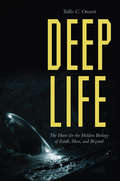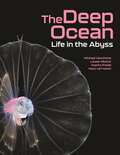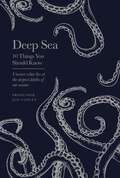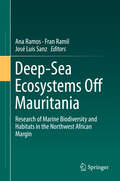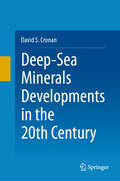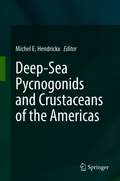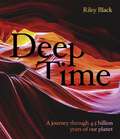- Table View
- List View
Deep Life: The Hunt for the Hidden Biology of Earth, Mars, and Beyond (PDF)
by Tullis C. OnstottDeep Life takes readers to uncharted regions deep beneath Earth's crust in search of life in extreme environments and reveals how astonishing new discoveries by geomicrobiologists are helping the quest to find life in the solar system.Tullis Onstott, named one of the 100 most influential people in America by Time magazine, provides an insider’s look at the pioneering fieldwork that is shining vital new light on Earth’s hidden biology—a thriving subterranean biosphere that scientists once thought to be impossible. Come along on epic descents two miles underground into South African gold mines to experience the challenges that Onstott and his team had to overcome. Join them in their search for microbes in the ancient seabed below the desert floor in the American Southwest, and travel deep beneath the frozen wastelands of the Arctic tundra to discover life as it could exist on Mars.Blending cutting-edge science with thrilling scientific adventure, Deep Life features rare and unusual encounters with exotic life forms, including a bacterium living off radiation and a hermaphroditic troglodytic worm that has changed our understanding of how complex subsurface life can really be. This unforgettable book takes you to the absolute limits of life—the biotic fringe—where today’s scientists hope to discover the very origins of life itself.
Deep Marine Mineral Resources
by Yves Fouquet Denis LacroixThe risks of shortages for some crucial metals and uncertainty about the land-based reserves of several others justify the search to diversify our sources of supply and investigate their potential. Mineral resources in the deep sea are attracting increasing interest with the progressive discovery of various forms of ores. France possesses large areas of deep seafloor in the three oceans as well as world-class human and technological resources and know-how, resulting from over 40 years of experience. This study takes stock of knowledge about mineralisations and associated metals, technologies for exploring and exploiting them, biodiversity and the potential impact of exploitation on the deep environment and the partnerships which are vital for France and Europe. This information will be useful for decision-makers in drawing up strategies, defining research and development programmes and in enhancing and developing commercial utilizations for these high-potential resources.
Deep Marine Systems: Processes, Deposits, Environments, Tectonics and Sedimentation (Wiley Works)
by Kevin T. Pickering Richard N. HiscottDeep-water (below wave base) processes, although generally hidden from view, shape the sedimentary record of more than 65% of the Earth’s surface, including large parts of ancient mountain belts. This book aims to inform advanced-level undergraduate and postgraduate students, and professional Earth scientists with interests in physical oceanography and hydrocarbon exploration and production, about many of the important physical aspects of deep-water (mainly deep-marine) systems. The authors consider transport and deposition in the deep sea, trace-fossil assemblages, and facies stacking patterns as an archive of the underlying controls on deposit architecture (e.g., seismicity, climate change, autocyclicity). Topics include modern and ancient deep-water sedimentary environments, tectonic settings, and how basinal and extra-basinal processes generate the typical characteristics of basin slopes, submarine canyons, contourite mounds and drifts, submarine fans, basin floors and abyssal plains.
Deep Marine Systems: Processes, Deposits, Environments, Tectonics and Sedimentation (Wiley Works)
by Kevin T. Pickering Richard N. HiscottDeep-water (below wave base) processes, although generally hidden from view, shape the sedimentary record of more than 65% of the Earth’s surface, including large parts of ancient mountain belts. This book aims to inform advanced-level undergraduate and postgraduate students, and professional Earth scientists with interests in physical oceanography and hydrocarbon exploration and production, about many of the important physical aspects of deep-water (mainly deep-marine) systems. The authors consider transport and deposition in the deep sea, trace-fossil assemblages, and facies stacking patterns as an archive of the underlying controls on deposit architecture (e.g., seismicity, climate change, autocyclicity). Topics include modern and ancient deep-water sedimentary environments, tectonic settings, and how basinal and extra-basinal processes generate the typical characteristics of basin slopes, submarine canyons, contourite mounds and drifts, submarine fans, basin floors and abyssal plains.
The Deep Ocean: Life in the Abyss
by Michael Vecchione Louise Allcock Imants Priede Hans van HarenAn epic excursion into one of the last great frontiers on EarthThe deep ocean comprises more than 90 percent of our planet’s biosphere and is home to some of the world’s most dazzling creatures, which thrive amid extreme pressures, scarce food supplies, and frigid temperatures. Living things down here behave in remarkable and surprising ways, and cutting-edge technologies are shedding new light on these critically important ecosystems. This beautifully illustrated book leads you down into the canyons, trenches, and cold seeps of the watery abyss, presenting the deep ocean and its inhabitants as you have never seen them before.Features a wealth of breathtaking photos, illustrations, and graphicsGives a brief and accessible history of deep-sea explorationExplains the basics of oceanographyCovers a marvelous diversity of undersea organismsDescribes habitats ranging from continental slopes to hydrothermal vents and abyssal plainsDiscusses humanity’s impacts on the deep ocean, from fisheries and whaling to global climate change and acidificationWritten by a team of world-class scientists
The Deep Proterozoic Crust in the North Atlantic Provinces (Nato Science Series C: #158)
by Alex C. Tobi Jacques L. R. TouretThe Proterozoic terrains of South Scandinavia and the Grenville Province in North-America have many common features : Regional high grade metamorphism (Granulite-facies), anorthosites, etc. They are separated by the Caledonian orogeny and, above all, by the Atlantic Ocean. During the time of the great continental drift controversy, few people were ready to admit that both sides on the Atlantic were once an unique province. Now everybody agrees on the Post-paleozoic age of the Atlantic and, consequently, on the intrinsic homogeneity of the much older. rocks which occur around it. But a detailed comparison is not easy. The Grenville Province is much larger than South Scandinavia, both regions have been investigated by a great number of different schools, using various methods, approaches and concepts. After several attempts, and long discussion, it was felt by a small group of individuals, that literature study would not be enough and that nothing could re place the direct contact, in the field, of specialists who had a first hand knowledge of all involved regions. The formula of a NATO Advanced Study Institute, which gives a unique opportunity to meet and mix people of various origin and levels, came almost by itself. Much work was needed, much help has been obtained, as detailed in the "Acknowledgements".
Deep Sea: 10 Things You Should Know
by Jon CopleyUncover what lies at the deepest depths of our oceans...In ten brief and informative essays, marine biologist and TV science advisor Professor Jon Copley journeys to one of the most mysterious and fascinating environments on Earth, the deep sea. Discover what makes this unique habitat such a challenging environment, the creatures that call it home and how ocean explorers are able to utilise the latest technology to aid their research and travel miles below the ocean surface.The Deep Sea: 10 things you should know is a brilliant guide to one of the most fascinating and curious places known to humankind.
Deep-Sea Ecosystems Off Mauritania: Research of Marine Biodiversity and Habitats in the Northwest African Margin
by Ana Ramos Fran Ramil José Luis SanzThis book compiles the main findings of the multidisciplinary long-term research program developed in the continental margin of one of the more productive and unknown areas of the world oceans, Northwest Africa. The more than 25,000 preserved fishes and benthic invertebrates and quantitative data collected in 342 trawling stations, the 267 oceanographic profiles, the 211 sediment samples and the 28,122 km2 prospected by multi˗beam echo sounding allowed to obtain an overview of the amazing biodiversity of the demersal and benthic fauna inhabiting soft- and hard-bottom habitats, as well as the fascinating geomorphology and oceanography, hidden in the Mauritanian slope.
Deep-Sea Food Chains and the Global Carbon Cycle (Nato Science Series C: #360)
by G. T. Rowe Vita ParienteCarbon dioxide and other `greenhouse' gases are increasing in the atmosphere due to the burning of fossil fuels, the destruction of rain forests, etc., leading to predictions of a gradual global warming which will perturb the global biosphere. An important process which counters this trend toward potential climate change is the removal of carbon dioxide from the surface ocean by photosynthesis. This process packages carbon in phytoplankton which enter the food chain or sink into the deep sea. Their ultimate fate is a `rain' of organic debris out of the surface-mixed layer of the ocean. On a global scale, the mechanisms and overall rate of this process are poorly known. The authors of the 25 papers in this volume present their state-of-the-art approaches to quantifying the mechanisms by which the `rain' of biogenic debris nourishes deep ocean life. Prominent deep sea ecologists, geochemists and modelers address relationships between data and models of carbon fluxes and food chains in the deep ocean. An attempt is made to estimate the fate of carbon in the deep sea on a global scale by summing up the utilization of organic matter among all the populations of the abyssal biosphere. Comparisons are made between these ecological approaches and estimates of geochemical fluxes based on sediment trapping, one-dimensional geochemical models and horizontal (physical) input from continental margins. Planning interdisciplinary enterprises between geochemists and ecologists, including new field programs, are summarized in the final chapter. The summary includes a list of the important gaps in understanding which must be addressed before the role of the deep-sea biota in global-scale processes can be put in perspective.
Deep-Sea Minerals Developments in the 20th Century
by David S. CronanThe book is an historical monograph on deep-sea mineral-related activities and attitudes towards deep-sea mining in the 20th Century which makes comparisons with the current situation in regard to those activities and attitudes. It reviews developments in the study of, and prospects and plans for mining deep-sea manganese nodules, cobalt-rich crusts, hydrothermal deposits, and phosphorites, and discusses associated environmental, technological, and economic issues. It is based on several sources. First, the author’s experience gleaned from around 50 years of attending conferences on the subject (the most important of which was the annual Underwater Mining Institutes held from 1970 onwards at which much of the material in the book was first exposed), second, discussions with and advice from the author's colleagues on the subject, all attributed, and third, the published literature. The target audiences are marine mining companies and their associates, marine environmentalists, UN and Government administrators responsible for seabed activities, undergraduate students of marine affairs and history, and interested lay persons. Unique features include the widespread sources used including unpublished conference proceedings and reports, personal insights gleaned from more than 50 years of working in the field, the author’s publications dating from 1967-2022, and attributed personal communications from the author’s colleagues.
Deep-Sea Mining: Resource Potential, Technical and Environmental Considerations
by Rahul SharmaThis comprehensive book contains contributions from specialists who provide a complete status update along with outstanding issues encompassing different topics related to deep-sea mining. Interest in exploration and exploitation of deep-sea minerals is seeing a revival due to diminishing grades and increasing costs of processing of terrestrial minerals as well as availability of several strategic metals in seabed mineral resources; it therefore becomes imperative to take stock of various issues related to deep-sea mining. The authors are experienced scientists and engineers from around the globe developing advanced technologies for mining and metallurgical extraction as well as performing deep sea exploration for several decades. They invite readers to learn about the resource potential of different deep-sea minerals, design considerations and development of mining systems, and the potential environmental impacts of mining in international waters.
Deep-Sea Mining and the Water Column: Advances, Monitoring and Related Issues
by Rahul SharmaThis book focuses on general issues of deep-sea mining for seafloor mineral deposits, as well as the scientific, technical, legal and policy issues related to impacts on the water column. The topic is a growing area of significance due to the ongoing conversations on this issue in the world community, in view of the large-scale consequences resulting from operations of different components of deep-sea mining systems. The chapters are divided in five sections, and are contributed by highly acclaimed scientists, technologists, lawyers and administrators who have decades of experience working on these topics. The information compiled in the book is expected to serve as an important reference for all stakeholders including researchers, contractors, mining companies, regulators and NGOs involved in deep-sea mining and marine environmental conservation. Section 1 provides an overall view of the current status of deep-sea mining and issues related to the water column. Section 2 looks at the engineering considerations for technology related to mining, handling of bulk solids in the marine environment, transporting the ores from seabed to shore as well as processing of deep-sea minerals. Section 3 discusses various approaches for assessment of impacts of deep-sea mining on the water column. Section 4 assesses the chemical, physical and biological characteristics of the water column in different oceans of the world. Finally, section 5 deals with legal, policy and economic aspects of deep-sea mining.
Deep-Sea Pycnogonids and Crustaceans of the Americas
by Michel E. HendrickxAmong the deep-sea marine invertebrates, pycnogonids and crustaceans represent ecologically important and most diverse groups of species. Yet both are still poorly understood. Sampling and exploring operations off the west and east coast of the Americas has significantly increased in the last two decades. However such operations are very costly and limited in number and frequency. In countries like Brazil, Canada, Chile, Colombia, Costa Rica, Mexico, Peru, the United States of America, and El Salvador a large effort has been made to explore the deep-sea resources and the rich diversity of the communities, resulting in a better understanding of the natural ecosystems on both coasts of America. Pycnogonids and many groups of deep-sea crustaceans have been intensively studied, from the smallest animals, like the mostly unknown benthic copepods to the largest decapods.This book presents new and updated information on various groups of deep-sea pycnogonids and crustaceans occurring off the American continent. Offering a valuable reference resource for scientists interested in this fascinating fauna, it includes review papers and new data on the deep-sea communities occurring off the USA, Mexico, El Salvador, Costa Rica, Colombia, Chile, Peru, Brazil and Argentina, as well as in larger areas in both the East Pacific and the West Atlantic. As such it covers most of the current deep-water research in Latin America.
Deep-Sea Sediments: Physical and Mechanical Properties (Marine Science #2)
by Anton InderbitzenAs part of its continuing program to stimulate superior basic research in the marine environment, the Office of Naval Research, Ocean Science and Technology Division, sponsored a series of closed seminar-workshops in 1972-1973. Each seminar focused upon one re search area of marine geology which is relatively new and in need of a critical evaluation and accelerated support. The subjects areas chosen for the seminars were: 1. natural gases in marine sediments and their mode of distribution, 2. nephelometry and the optical properties of ocean waters, 3. physical and engineering properties of deep-sea sediments, and 4. physics of sound in marine sediments. The objectives of each seminar-workshop were to bring into sharper focus the state-of-the-science within each subject area, to effect some degree of coordination among the investigators working within each of these areas and to provide the Ocean Science and Technology Division guidance for national program support. This volume.contains most of the papers presented at the semi nar on the physical and engineering properties of deep-sea sediments. The seminar was held at Airlie House, Airlie, Virginia on April 24- 27, 1973 and was organized and chaired by A. Inderbitzen. The at tendees were invited from among the leading investigators in this field from both the engineering and scientific disciplines. Each attendee was requested to prepare a paper within his area of spe ciality.
Deep Seismic Sounding of the Earth’s Crust and Upper Mantle
by Irina P. KosminskayaDeep seismiC sounding was proposed by G. A. Gamburtsev and developed under his guid ance during the period 1948-1955 at the Institute of Physics of the Earth of the Academy of Sciences of the USSR. During that period also, the first geophysical results concerning the deep structure of the earth's crust in several regions in Tien-Shan, the Pamir, and Turkmenia were observed. Beginning with 1956, the deep seismic sounding method has been used widely by geo physical research groups as well as by geophysical service organizations for regional studies in the USSR. Descriptions of this work have been given in reports by Yu. N. Godin, V. V. Fedynskii, D. N. Kazanli, and others. New variants of the deep seismic sounding method have been developed; continuous profiling (Yu. N. Godin, and others), and point soundings (N. N. Puzyrev, and others). Deep seismic soundings have been carried on outside of Russia also, and studies have been carried out on the use of the deep seismic sounding method in marine applications (E. I. Gal'perin, S. M. Zverev, 1. P. Kosminskaya, Yu. P. Neprochnov, and others). OVer the past decade, the deep seismic sounding method has joined the suite of geo physical studies as a highly detailed method for studying the earth's crust and upper mantle to depths of 50 to 100 km on land, and of 15 to 25 km in the deep oceans.
Deep Time: A journey through 4.5 billion years of our planet
by Riley BlackDeep time is the timescale of the geological events that have shaped our planet. Whilst so immense as to challenge human understanding, its evidence is nonetheless visible all around us. Through explanations of the latest research and over 200 fascinating images, Deep Time explores this evidence, from the visible layers in ancient rock to the hiss of static on the radio, and from fossilized shark's teeth to underwater forests. These relics of ancient epochs, many of which we can see and touch today, connect our present to the distant past and answer broader questions about our place in the timeline of the Earth.Charting 4.5 billion years of geological history, this is the story of our world, from its birth to the dawn of civilization.
Deep Time: A Literary History
by Noah HeringmanHow the concept of “deep time” began as a metaphor used by philosophers, poets, and naturalists in the eighteenth and nineteenth centuriesIn this interdisciplinary book, Noah Heringman argues that the concept of “deep time”—most often associated with geological epochs—began as a metaphorical language used by philosophers, poets, and naturalists of the eighteenth and nineteenth centuries to explore the origins of life beyond the written record. Their ideas about “the abyss of time” created a way to think about the prehistoric before it was possible to assign dates to the fossil record. Heringman, examining stories about the deep past by visionary thinkers ranging from William Blake to Charles Darwin, challenges the conventional wisdom that the idea of deep time came forth fully formed from the modern science of geology. Instead, he argues, it has a rich imaginative history.Heringman considers Johann Reinhold Forster and Georg Forster, naturalists on James Cook’s second voyage around the world, who, inspired by encounters with Pacific islanders, connected the scale of geological time to human origins and cultural evolution; Georges-Louis Leclerc, Comte de Buffon, who drew on travel narrative, antiquarian works, and his own fieldwork to lay out the first modern geological timescale; Blake and Johann Gottfried Herder, who used the language of fossils and artifacts to promote ancient ballads and “prehistoric song”; and Darwin’s exploration of the reciprocal effects of geological and human time. Deep time, Heringman shows, has figural and imaginative dimensions beyond its geological meaning.
Deep Time: A Literary History
by Noah HeringmanHow the concept of “deep time” began as a metaphor used by philosophers, poets, and naturalists in the eighteenth and nineteenth centuriesIn this interdisciplinary book, Noah Heringman argues that the concept of “deep time”—most often associated with geological epochs—began as a metaphorical language used by philosophers, poets, and naturalists of the eighteenth and nineteenth centuries to explore the origins of life beyond the written record. Their ideas about “the abyss of time” created a way to think about the prehistoric before it was possible to assign dates to the fossil record. Heringman, examining stories about the deep past by visionary thinkers ranging from William Blake to Charles Darwin, challenges the conventional wisdom that the idea of deep time came forth fully formed from the modern science of geology. Instead, he argues, it has a rich imaginative history.Heringman considers Johann Reinhold Forster and Georg Forster, naturalists on James Cook’s second voyage around the world, who, inspired by encounters with Pacific islanders, connected the scale of geological time to human origins and cultural evolution; Georges-Louis Leclerc, Comte de Buffon, who drew on travel narrative, antiquarian works, and his own fieldwork to lay out the first modern geological timescale; Blake and Johann Gottfried Herder, who used the language of fossils and artifacts to promote ancient ballads and “prehistoric song”; and Darwin’s exploration of the reciprocal effects of geological and human time. Deep time, Heringman shows, has figural and imaginative dimensions beyond its geological meaning.
Deep Time Analysis: A Coherent View of the History of Life (Springer Geology)
by Mark A.S. McMenaminUsing a series of case studies, the book demonstrates the power of dynamic analysis as applied to the fossil record. The book considers how we think about certain types of paleontological questions and shows how to answer them. The analytical tools presented here will have wide application to other fields of knowledge; as such the book represents a major contribution to the deployment of modern scientific method as it builds on author's previous book, Dynamic Paleontology. Students and seasoned professionals alike will find this book to be of great utility for refining their approach to their ongoing and future research projects.
The Deep Universe: Saas-Fee Advanced Course 23. Lecture Notes 1993. Swiss Society for Astrophysics and Astronomy (Saas-Fee Advanced Course #23)
by A.R. Sandage R.G. Kron M.S. LongairWritten by three celebrated astronomers renowned for their excellence in both research and teaching, the central theme is approached in three complementary ways: the smooth evolution of the universe from the Big Bang to the present structures of matter; as a meandering road paved by our observations of stars, galaxies, and clusters; and how these approaches have been gradually developed and intertwined in the historical process leading to modern-day cosmology.
Deep Water: From the Frilled Shark to the Dumbo Octopus and from the Continental Shelf to the Mariana Trench
by Riley BlackFrom celebrated science writer Riley Black, a beautifully illustrated, compelling deep dive into the life story of the abyss, its ancient creatures, and the scientists and submersibles that have documented them. What lies beneath the surface of the ocean has mystified humankind for millennia. Today, we have explored more of the surface of the Moon than we have the deep sea. What thrives in these mysterious depths, how did these life-forms evolve from ancient life, and how has this environment changed over time as our planet has developed? Introducing us to the ancient, complex, and fascinating life-forms that have evolved into the marine life we recognize today—from stromatolites, structures created by some of the earliest life billions of years ago and still found today, to yeti crabs, bioluminescent firefly squid, and giant jellyfish—Deep Water is an eye-opening journey into the world far beneath the waves. Our guide, brilliant science communicator and self-described “fossil fanatic” Riley Black, has studied marine biology and paleontology, and she brings her vast knowledge and inimitable voice to our voyage. Through text and image, Black leads us further and further into the depths to reveal how this unique and largely unexplored habitat came into being, what lives there and why, how it has evolved, and what the future will bring in this dark and mysterious environment.
Deep-water Coral Reefs: Unique Biodiversity Hot-Spots (Springer Praxis Books)
by Martin HovlandDeep-water coral reefs are found along large sections of the outer continental shelves and slopes of Europe, from North Cape to the Gulf of Cadiz, and because they also occur along the Atlantic seaboard of USA, the Gulf of Mexico, off Brazil, in the Mediterranean, and off New Zealand, they are currently being targeted by international groups of marine scientists. They have become popular and opportune deep-water research targets because they offer exciting frontier exploration, combined with a whole plethora of modern scientific methods, such as deep-sea drilling, sampling, remote control surveying and documentation. Furthermore they represent timely opportunities for further developments within the application of geochemistry, stable isotope research, bacterial sciences, including DNA-sequestering, and medical research (search for bioactive compounds). The Integrated Ocean Drilling Program (IODP) has arranged a deep-sea scientific drilling campaign on giant carbonate banks off Ireland. Because the reefs currently defy traditional marine-ecological theories, they represent future research opportunities and will enjoy scientific scrutiny for many years to come.
Deep-Water Turbidite Systems (International Association Of Sedimentologists Series #68)
by Dorrik A. V. StowThis third volume in the IAS Reprint Series reviews some of the major contributions that have been made over the last twenty years to our understanding of deep water environments. Few groups of rocks have received as much attention in recent years as deep sea sands and yet retained so many unsolved problems - How far and how fast can sediment debris flows travel? Do the many ancient series that have been interpreted as submarine fan deposits bear any resemblance to present day deep sea flows? How valid are the sequences described as coarsening upward or fining upward, and how should they be interpreted? This timely review of contributions made to this area of study since 1970 reflects the heightened interest that has surrounded it. Deep Water Turbidite Systems contains 22 papers (reproduced in full) and 22 abstracts of papers that have appeared in the journal Sedimentology, concerned with the broad spectrum of topics within the field of turbidites and associated deep water systems. If you are a member of the International Association of Sedimentologists, for purchasing details, please see: http://www.iasnet.org/publications/details.asp?code=RP3
Deepwater Geohazards in the South China Sea
by Shiguo Wu Yunbao Sun Qingping Li Jiliang Wang Dawei Wang Qiliang Sun Chuanxu Chen Yangbing XieThis book comprehensively analyzes and summarizes the types, characteristics and prevention of deep-sea geological disasters in the South China Sea based on the research progress of global background. It also brings attention to the general public and stakeholders the risks of deep-sea geological disasters.
